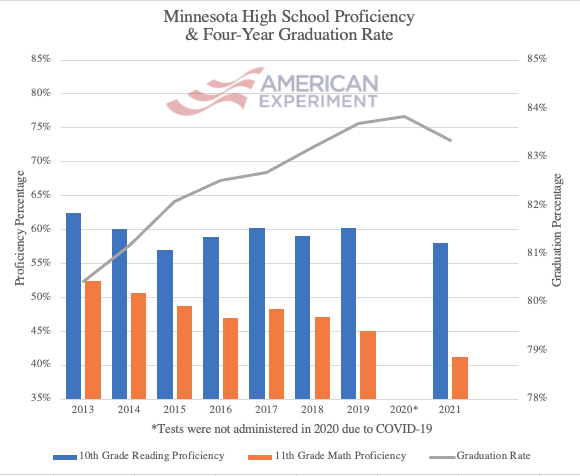Minnesota’s graduation rate is up, but proficiency is not
The four-year graduation rate for Minnesota’s high school students has steadily been increasing over the years, which should be cause for celebration. But not when student proficiency in math is in decline and nearly 42 percent of 10th graders can’t read at grade level.
While the 2021 graduation rate dropped slightly, it has otherwise been maintaining a consistent upward trend over the years, even in spring 2020 despite COVID-19 and a switch to distance learning.
High school math and reading proficiency, however, have not consistently improved.
High school students take the reading Minnesota Comprehensive Assessment (MCA) in 10th grade and the math MCA in 11th grade. In 2019, 55 percent of 11th graders were not performing at grade level in math. The following year, the graduation rate was 83.8 percent. As of 2021 data — the most recent available — nearly 59 percent of 11th graders didn’t demonstrate math proficiency. Reading scores over the years have been stagnant at best.
The chart below tracks high school proficiency and the state’s four-year graduation rate since 2013, when the reading MCA was revamped to align with national “Common Core” academic standards. The math MCA was revised in 2011 based on the state’s amended math standards.
In 2013, the legislature removed required minimum test scores for a high school diploma, diluting Minnesota’s high school graduation requirements and allowing students who don’t demonstrate proficiency to still graduate.

Limited picture
Increased graduation rates do not automatically equate to improved learning or academic achievement. And often paint a limited picture of how all students’ needs are being met. According to 2019 ACT Research data, 31 percent of Minnesota high school graduates met zero college readiness benchmarks.
We must prioritize improving academic proficiency with the same sense of urgency behind improving graduation rates. What can we learn from other states? And where are the results of all our spending?
While more students may be leaving high school with a diploma, data show an increasing proportion of those students are unprepared for college and other post-secondary options. However, given higher education institutions’ own lowering of standards, maybe Minnesota students are on track, after all.